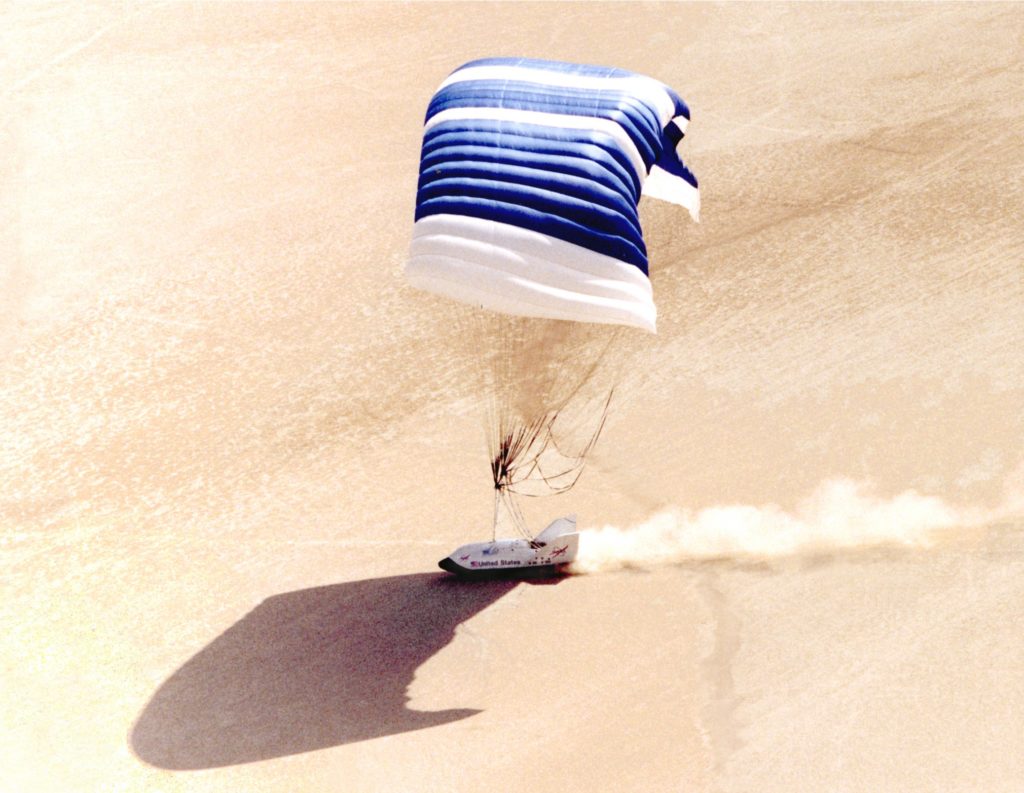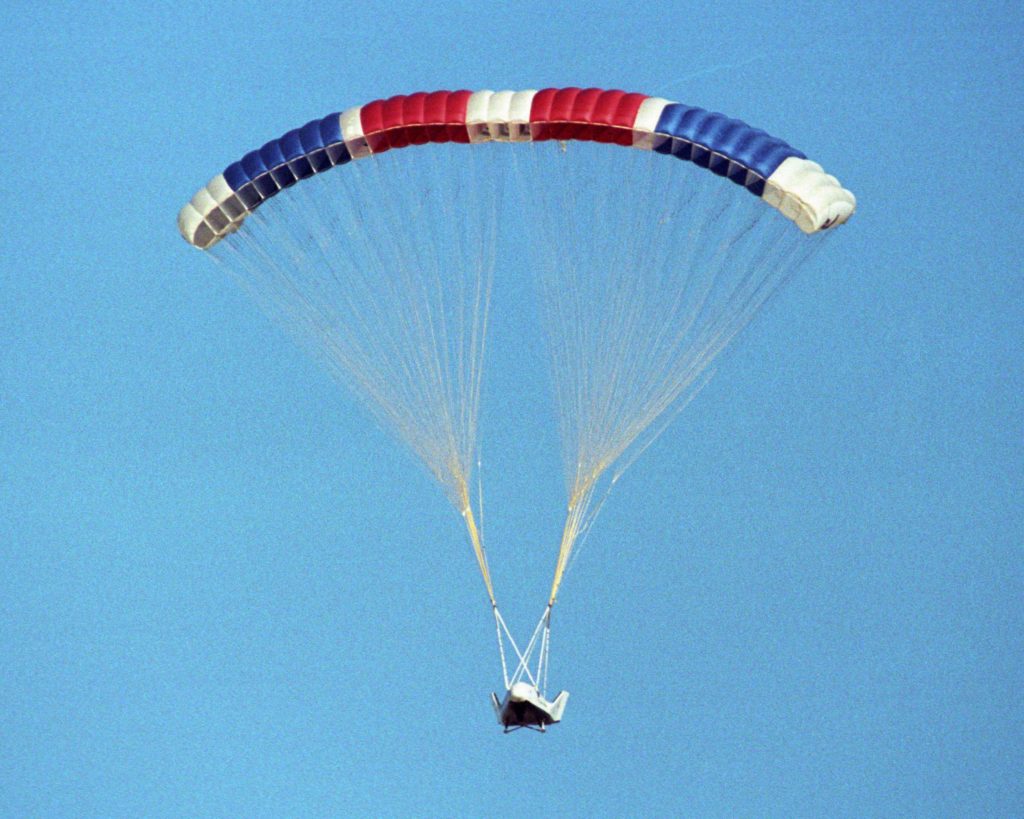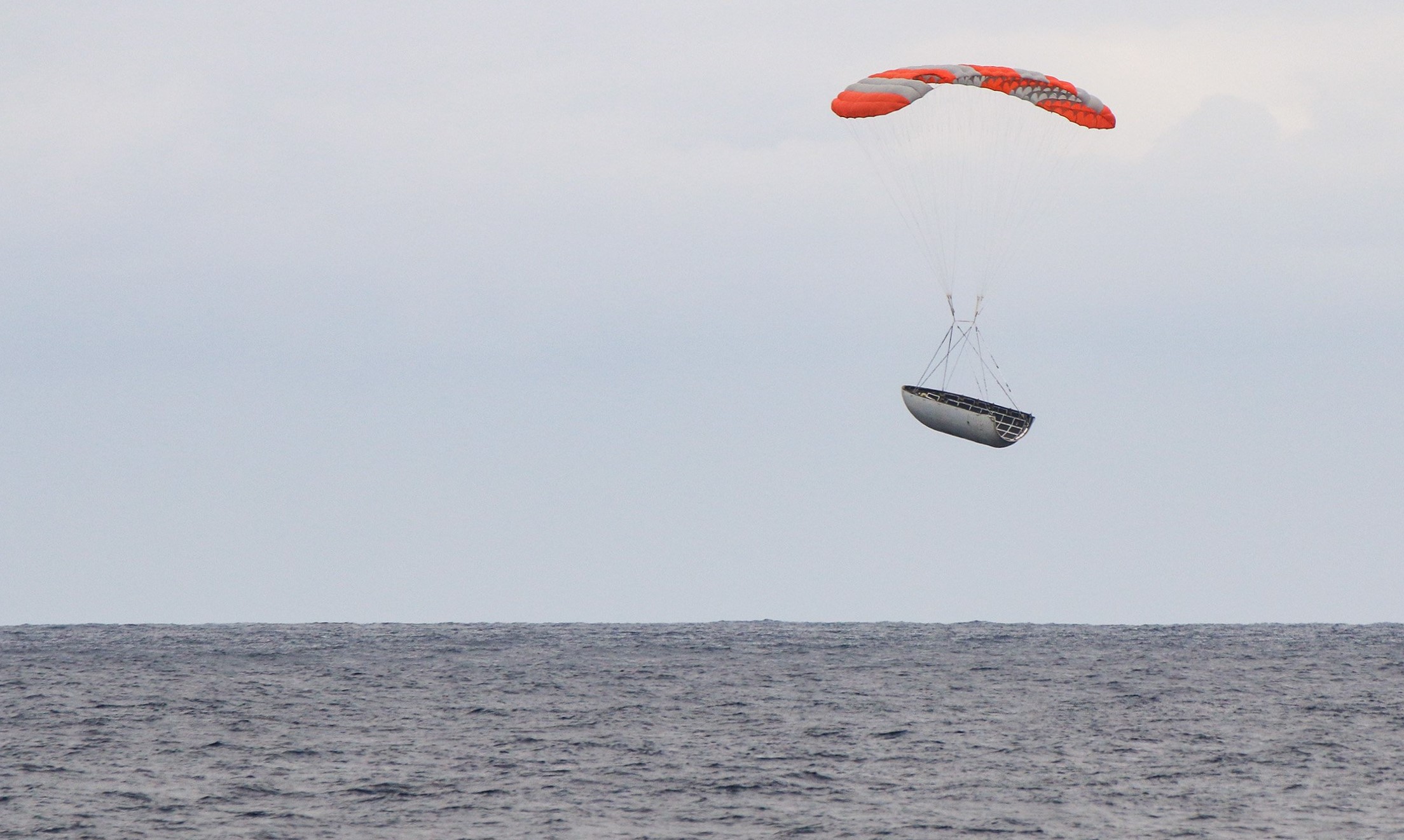
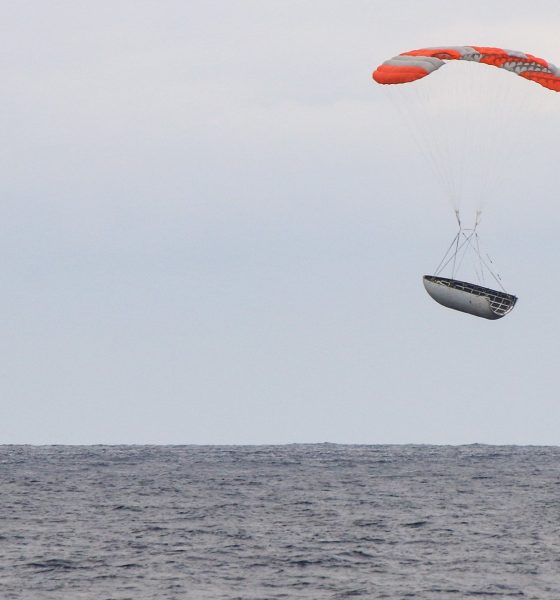
News
SpaceX will use a parasail guidance system to land Falcon 9’s fairing into a huge net
SpaceX recovery vessel Mr Steven officially departed Port of Los Angeles on the evening of July 23 and is speeding towards its first Falcon 9 fairing recovery attempt since a major series of refits and upgrades. With massive new arms and usable net area increased fourfold, chances are better than they’ve ever been for the iconic clawboat to at last snag its first true ‘catch’ of a parasailing payload fairing.
Set to be stationed roughly 900 km (600 mi) southwest of the California coast, Mr Steven’s vast new net should dramatically even the playing field, cutting the effective error margin for each fairing catch attempt by as much as 60% on its own. An extra ~30 meters of net both length and width-wise would functionally act as a cushion for the ~50-meter accuracy the fairings have demonstrated thus far (i.e. halves missed Mr Steven’s smaller, original net by 50 m).
Still, the question remains for many people: how exactly does Mr Steven ‘catch’ a clamshell fairing half, and how does that fairing half find its way to Mr Steven?
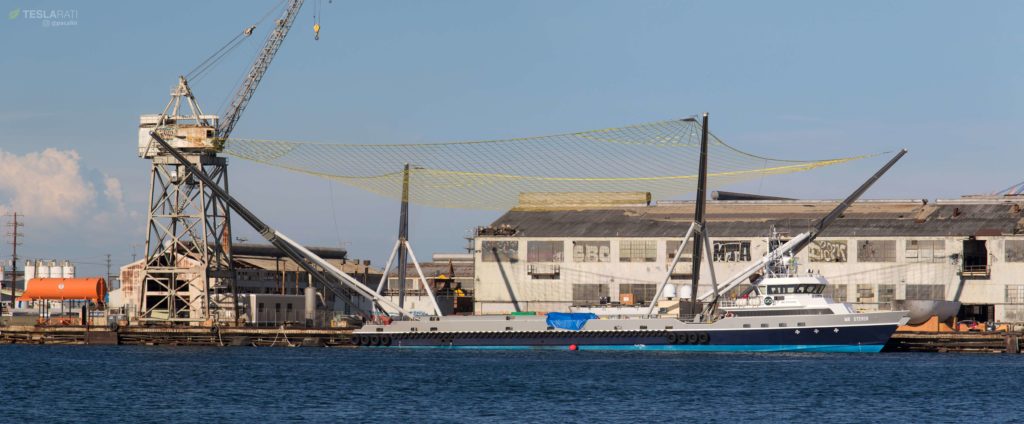
A parasail and a prayer
Each Falcon 9 fairing is a two-piece 1600 kg sandwich of carbon fiber composites and aluminum honeycomb, as well as internal dressings of soundproofing panels, cold nitrogen gas thrusters for attitude control in vacuum, and finally the parafoil and control hardware/avionics necessary to safely recover the fragile halves. Stretching 13m long and 5.2m wide (43ft x 17ft), SpaceX has partially worked with contractors already experts in the art of autonomously guiding parasails with payloads up to 10,000 kg (22,000 lb), and doing so with some level of accuracy.
Ultimately, GPS-guided parafoils have been done successfully many times over in the past two or so decades. For the most part, the problems preventing SpaceX from recovering fairings in Mr Steven’s net have been almost entirely solved: the fact that six or more halves have been recovered intact after their Falcon 9 launches confirm that much. SpaceX engineers have somehow found a way to allow a highly flexible, lightweight, and aerodynamically awkward lifting body to survive a journey from heights of 110+ km and speeds of several kilometers per second.
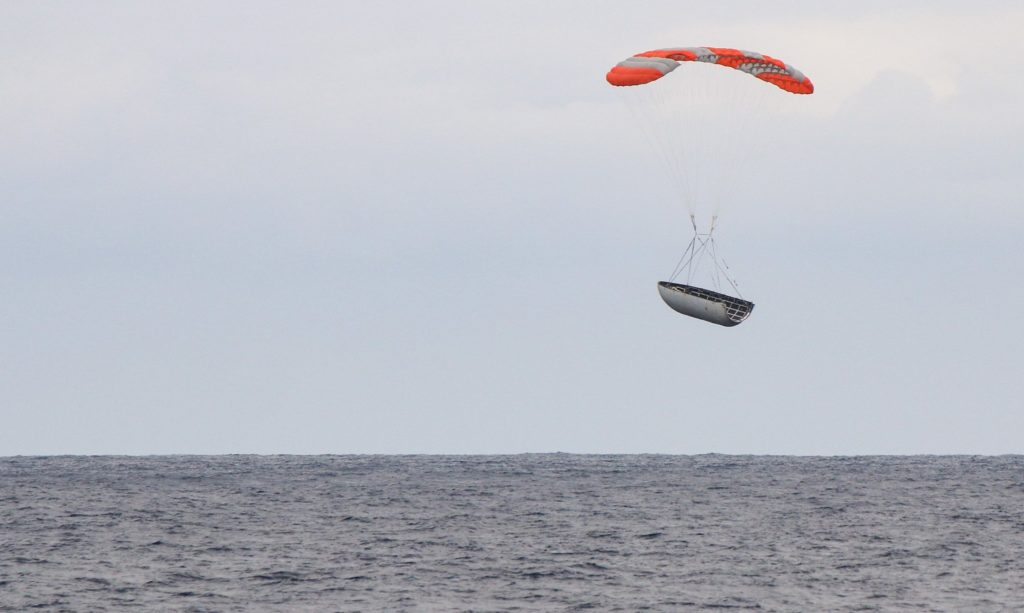
One half of SpaceX’s Iridium-6/GRACE-FO just moments before touchdown on the Pacific Ocean. (SpaceX)
Per the extraordinarily minimalist appearance of each half’s parafoil recovery hardware and the lack of any clear control mechanism, it’s very likely that SpaceX has sided with an in-canopy (canopy=the parachute) system of actuators tasked with subtly warping the parafoil, comparable in functionality to a crude replica of a bird’s wing.
When in doubt, copy birds
Birds fly with such extraordinary precision thanks to granular control surfaces known by most as “feathers”, whereby slightly tweaking the location of feathers or changing the shape of the wing can result in a huge range of behaviors. In-wing actuation and control is an elegant – if complex – solution for the problems posed by parafoil guidance. In this case, SpaceX’s contractor (MMIST) likely deserves at least some of the credit for several nearly successful catch attempts thus far, delivering each unpowered fairing half from an altitude of 110+ kilometers, speeds of more than 2 kilometers per second, and parabolic trajectories stretching over 800 kilometers to a square roughly 100m by 100m.
If each halve’s accuracy can be cut by 75% of that to an area of 50m by 50m, SpaceX and Mr Steven should have no trouble in reliably and routinely catching Falcon 9 payload fairings for rapid reusability, perhaps one day translating into a similar approach for the recovery of Falcon 9’s orbital upper stages and SpaceX’s Crew and Cargo Dragon spacecraft. Mr Steven’s new net upgrade is meant to accomplish exactly that by offering a much larger surface area for Falcon fairings to ‘aim’ at.
- NASA’s X-38 project demonstrated the functionality of autonomous parasail guidance in 1999. (NASA)
- By tweaking, pulling, and tensing or loosening any number of those lines with servo motors and actuators, one can very accurately control the flight characteristics of a parafoil. (NASA)
- From left to right, my best guess for each fairing is PAZ, Iridium-6 Half 1, Iridium-5, and Iridium-6 Half 2. (Pauline Acalin)
Once the massive 800-kilogram components can be captured in flight by Mr. Steven, it should be a fairly simple prospect for SpaceX to move from recovery to reuse, potentially saving as much as 10% ($6m) of the cost of each Falcon 9 and Falcon Heavy launch in one simple, fell swoop. Perhaps even more importantly, fairing reuse would remove some of the pressure placed on SpaceX’s composite production floor, which currently must support the fabrication of dozens of fairing halves, booster interstages, payload adapters, Falcon Heavy nose cones, and much more, including smaller subassemblies required for both Crew and Cargo Dragons.
BFR is gonna need all the composite design and manufacturing expertise it can get.
For prompt updates, on-the-ground perspectives, and unique glimpses of SpaceX’s rocket recovery fleet (including fairing catcher Mr Steven) check out our brand new LaunchPad and LandingZone newsletters!

News
Tesla starts showing how FSD will change lives in Europe
Local officials tested the system on narrow country roads and were impressed by FSD’s smooth, human-like driving, with some calling the service a game-changer for everyday life in areas that are far from urban centers.

Tesla has launched Europe’s first public shuttle service using Full Self-Driving (Supervised) in the rural Eifelkreis Bitburg-Prüm region of Germany, demonstrating how the technology can restore independence and mobility for people who struggle with limited transport options.
Local officials tested the system on narrow country roads and were impressed by FSD’s smooth, human-like driving, with some calling the service a game-changer for everyday life in areas that are far from urban centers.
Officials see real impact on rural residents
Arzfeld Mayor Johannes Kuhl and District Administrator Andreas Kruppert personally tested the Tesla shuttle service. This allowed them to see just how well FSD navigated winding lanes and rural roads confidently. Kruppert said, “Autonomous driving sounds like science fiction to many, but we simply see here that it works totally well in rural regions too.” Kuhl, for his part, also noted that FSD “feels like a very experienced driver.”
The pilot complements the area’s “Citizen Bus” program, which provides on-demand rides for elderly residents who can no longer drive themselves. Tesla Europe shared a video of a demonstration of the service, highlighting how FSD gives people their freedom back, even in places where public transport is not as prevalent.
What the Ministry for Economic Affairs and Transport says
Rhineland-Palatinate’s Minister Daniela Schmitt supported the project, praising the collaboration that made this “first of its kind in Europe” possible. As per the ministry, the rural rollout for the service shows FSD’s potential beyond major cities, and it delivers tangible benefits like grocery runs, doctor visits, and social connections for isolated residents.
“Reliable and flexible mobility is especially vital in rural areas. With the launch of a shuttle service using self-driving vehicles (FSD supervised) by Tesla in the Eifelkreis Bitburg-Prüm, an innovative pilot project is now getting underway that complements local community bus services. It is the first project of its kind in Europe.
“The result is a real gain for rural mobility: greater accessibility, more flexibility and tangible benefits for everyday life. A strong signal for innovation, cooperation and future-oriented mobility beyond urban centers,” the ministry wrote in a LinkedIn post.
News
Tesla China quietly posts Robotaxi-related job listing
Tesla China is currently seeking a Low Voltage Electrical Engineer to work on circuit board design for the company’s autonomous vehicles.

Tesla has posted a new job listing in Shanghai explicitly tied to its Robotaxi program, fueling speculation that the company is preparing to launch its dedicated autonomous ride-hailing service in China.
As noted in the listing, Tesla China is currently seeking a Low Voltage Electrical Engineer to work on circuit board design for the company’s autonomous vehicles.
Robotaxi-specific role
The listing, which was shared on social media platform X by industry watcher @tslaming, suggested that Tesla China is looking to fill the role urgently. The job listing itself specifically mentions that the person hired for the role will be working on the Low Voltage Hardware team, which would design the circuit boards that would serve as the nervous system of the Robotaxi.
Key tasks for the role, as indicated in the job listing, include collaboration with PCB layout, firmware, mechanical, program management, and validation teams, among other responsibilities. The role is based in Shanghai.
China Robotaxi launch
China represents a massive potential market for robotaxis, with its dense urban centers and supportive policies in select cities. Tesla has limited permission to roll out FSD in the country, though despite this, its vehicles have been hailed as among the best in the market when it comes to autonomous features. So far, at least, it appears that China supports Tesla’s FSD and Robotaxi rollout.
This was hinted at in November, when Tesla brought the Cybercab to the 8th China International Import Expo (CIIE) in Shanghai, marking the first time that the autonomous two-seater was brought to the Asia-Pacific region. The vehicle, despite not having a release date in China, received a significant amount of interest among the event’s attendees.
Elon Musk
Elon Musk and Tesla AI Director share insights after empty driver seat Robotaxi rides
The executives’ unoccupied tests hint at the rapid progress of Tesla’s unsupervised Robotaxi efforts.

Tesla CEO Elon Musk and AI Director Ashok Elluswamy celebrated Christmas Eve by sharing personal experiences with Robotaxi vehicles that had no safety monitor or occupant in the driver’s seat. Musk described the system’s “perfect driving” around Austin, while Elluswamy posted video from the back seat, calling it “an amazing experience.”
The executives’ unoccupied tests hint at the rapid progress of Tesla’s unsupervised Robotaxi efforts.
Elon and Ashok’s firsthand Robotaxi insights
Prior to Musk and the Tesla AI Director’s posts, sightings of unmanned Teslas navigating public roads were widely shared on social media. One such vehicle was spotted in Austin, Texas, which Elon Musk acknowleged by stating that “Testing is underway with no occupants in the car.”
Based on his Christmas Eve post, Musk seemed to have tested an unmanned Tesla himself. “A Tesla with no safety monitor in the car and me sitting in the passenger seat took me all around Austin on Sunday with perfect driving,” Musk wrote in his post.
Elluswamy responded with a 2-minute video showing himself in the rear of an unmanned Tesla. The video featured the vehicle’s empty front seats, as well as its smooth handling through real-world traffic. He captioned his video with the words, “It’s an amazing experience!”
Towards Unsupervised operations
During an xAI Hackathon earlier this month, Elon Musk mentioned that Tesla owed be removing Safety Monitors from its Robotaxis in Austin in just three weeks. “Unsupervised is pretty much solved at this point. So there will be Tesla Robotaxis operating in Austin with no one in them. Not even anyone in the passenger seat in about three weeks,” he said. Musk echoed similar estimates at the 2025 Annual Shareholder Meeting and the Q3 2025 earnings call.
Considering the insights that were posted Musk and Elluswamy, it does appear that Tesla is working hard towards operating its Robotaxis with no safety monitors. This is quite impressive considering that the service was launched just earlier this year.
